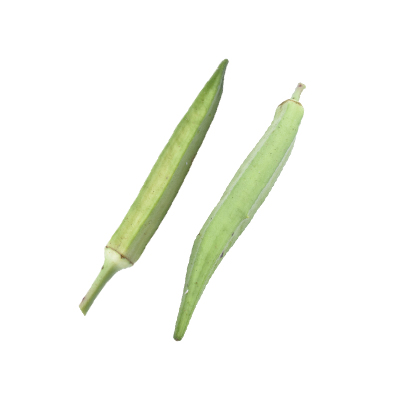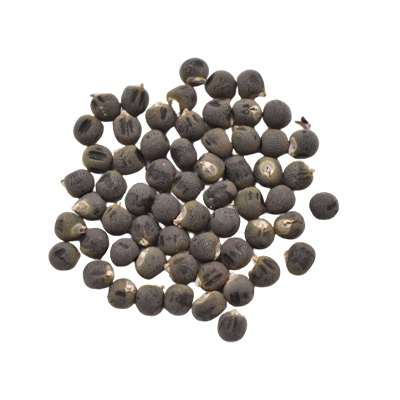Lady's Finger
Abelmoschus esculentus (L.) Moench
Malvaceae
Location in our garden
Vegetable
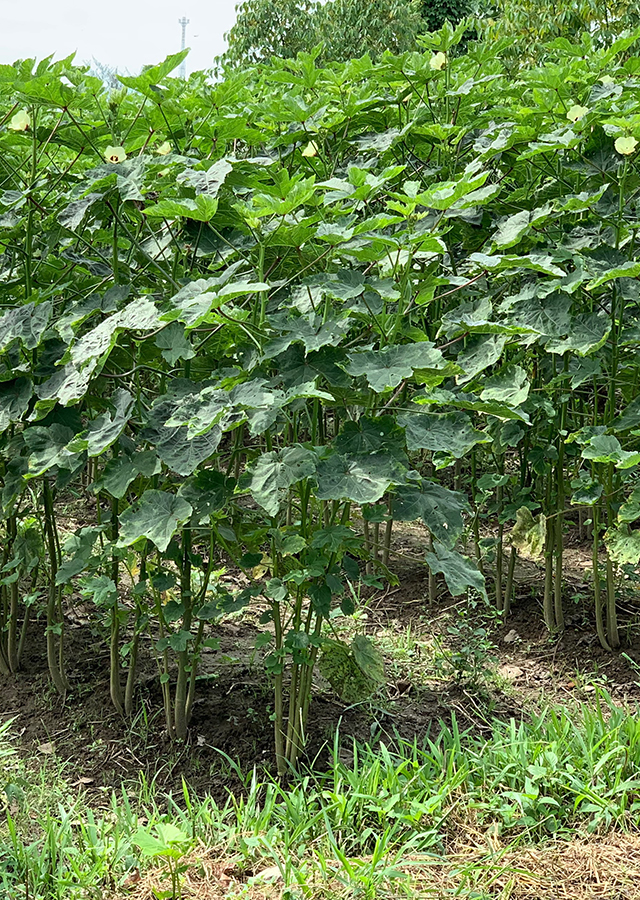
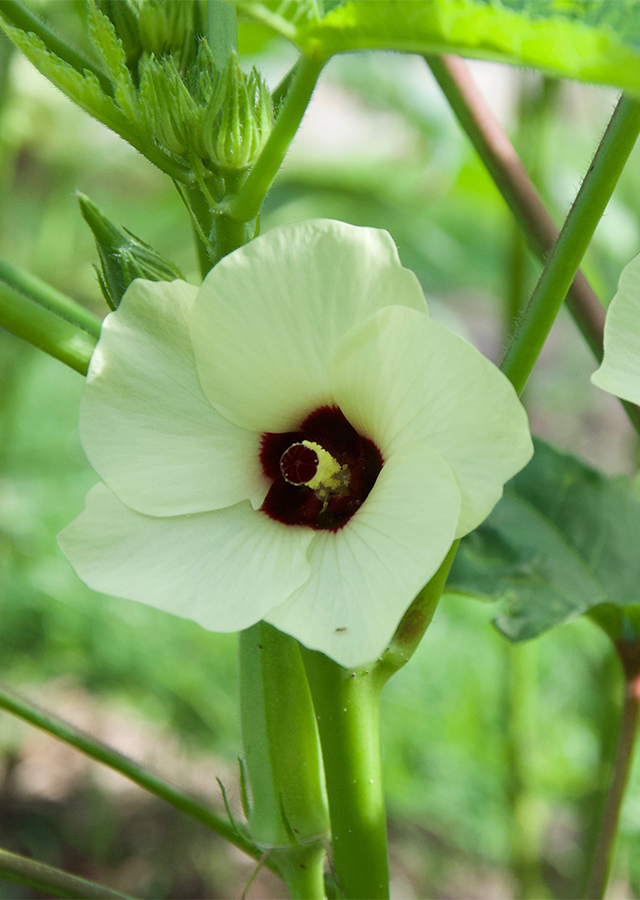
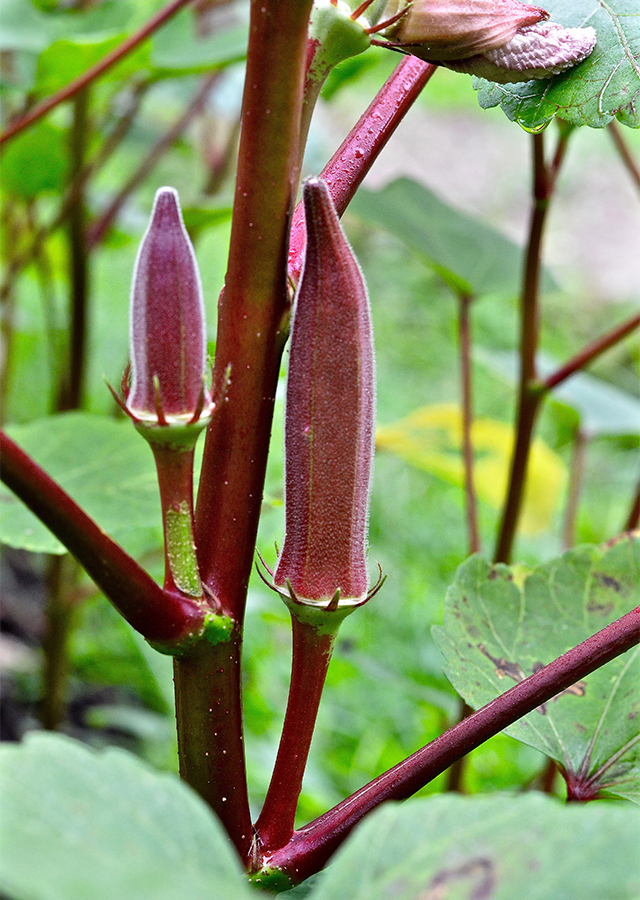
Synonym
Abelmoschus bammia Webb
Abelmoschus longifolius (Willd.) Kostel.
Abelmoschus officinalis (DC.) Endl.
Habitus
Herbaceous. Annual plant, erect, growing up to 4 m tall.
Part Used
Leaves
Seeds
Flowers
Fruit
Roots
Growing Requirements
Full Sunshine
Habitat
Terrestrial
Overview
It is uncertain where Lady's finger originates from, but the genus (Abelmoschus Medikus) comes from South-East Asia. It is widespread in tropical, subtropical and warm temperate regions, but it is particularly popular in West Africa, India, Philippines, Thailand, and Brazil. Thailand and Philippines even manage to export fresh Lady's finger to Japan. It is a good source of vitamins and minerals and has various medicinal uses as well as being the source of a good fibre.
Vernacular Names
Gombo (French), Quimbombo (Spanish), Bammia d'Egitto (Italian), Malve (Dutch), Okra (Tagalog-Philippines), Gronsakhibisk (Sweden). Okra, Kopi Arab (Indonesia), Kacang Bendi, Sayur Bendi, Kacang Lender (Malaysia), You-padi (Burma), Pôôt Barang (Cambodia), Khüa Ngwàng (Laos), Krachiap-Khieo (Thailand), Dậu Bắp, Bụ Bắp, Mướp Tây (Vietnam).
Agroecology
Lady's finger is well adapted to grow in the lowland humid tropics. It prefers a well-drained humus rich fertile soil in full sun and a temperature in the range of 20-30 °C for normal growth and development. A. esculentus is a short-day plant, but its wide geographical distribution (up to latitudes of 35-40°) indicates that cultivars differ markedly in sensitivity.
Morphology
- Stems - terete, with scattered, stiff hairs, glabrescent, often red-blotched.
- Leaves - arranged spirally, simple, leaf-blade up to 50 cm in diameter, variable in shape and size, more or less deeply 3-, 5- or 7-lobed; petiole up to 50 cm long, stipules filiform, up to 20 mm long, often split to the base.
- Flowers - solitary in the leaf axils or in pseudoracemes by reduction of the upper leaves, yellow, self-fertile; pedicel up to 3 cm long in flower, up to 7 cm long in fruit; epicalyx of 7-15 free, linear segments, 5-25 mm × 0.5-3 mm; calyx spathaceous, 2-6 cm long, splitting on one side during the expansion of the corolla, adnate to and falling with the corolla; corolla with 5 obovate petals, each about 3-7 cm long and wide, yellow with a dark purple centre.
- Fruits - cylindrical to pyramidal capsule, 5-35 cm long, 1-5 cm in diameter, completely, partially or not loculicidal, green, greenish-purple or completely purple when young, brownish when mature.
- Seeds - globose to ovoid, 3–6 mm in diameter, with minute warts in concentric rows, rarely with long red hairs on the seed coat, numerous, blackish.
Cultivation
It is mostly cultivated by seeds. To soften the hard seed coat, the seeds should be pre-soaked for 24 hours in warm water and then sow in situ. A minimum soil temperature of 16 °C is required for the seed to germinate. The seed germinates in 27 days at 15 °C or 6 days at 35 °C. Rows should be made in east-west direction to capture the most sunlight.
Chemical Constituents
- Oxalic acid, malic acid, shikimic acid, citric acid, fumaric acid, α-tocopherol, ϒ-tocopherol, α pinene, linalool, camphor, menthol, eugenol, quercetin, kaempferol
Traditional Medicinal Uses
Root
Extract: Demulcent and emollient poultice (India)
Juice : treatment of cuts, wounds and boils (Nepal)
Infusion : treatment of syphilis (India, Malaya), stomachic, treatment of diabetes, ulcer, and jaundice, also used as laxative (Nicoragua's Atlantic Coast and Turkey)
Leaves
Extract : mixed with egg albumin and applied on hair for black and silky hair (India), treatment of tumour (Latin America)
Flower
The decoction of the leaves and flowers: treatment of bronchitis and pneumonia (India)
Fruit
Infusion of the fruit mucilage : treatment of dysentery and diarrhoea in acute inflammation and irritation of the stomach, bowels, and kidneys catarrhal infections, ardour urinae, dysuria, diuretic, plasma replacement and gonorrhea, antipyretic and plasma replacement (India)
A decoction of the immature fruit : Demulcent and emollient poultice (India)
Seed
Antispasmodic, cordial and stimulant, treatment of spermatorrhoea (India), managing increased blood glucose concentration (Turkey), remedies for tumour (Latin America)
Infusion of the roasted seeds: having sudorific properties (India), for diabetes mellitus therapy (Turkey)
Part Used
Reference Sources
Benchasri, S. 2012. Okra (Abelmoschus esculentus (L.) Moench) as a Valuable Vegetable of the World. Ratar. Povrt. 49: 105-112.
Siemonsma, J. S. and Piluek, K. (Editors). 1993. Plant Resources of South-East Asia No 8. Vegetables. Prosea Foundation, Bogor, Indonesia. 412 pp.
Romdhane, M.H., Chahdoura, H., Barros, L. et al. 2020. Chemical Composition, Nutritional Value, and Biological Evaluation of Tunisian Okra Pods (Abelmoschus esculentus (L.) Moench. Molecules. 25, 4739
Chanchal, D.K., Alok, S., Kumar, M. et al. 2018. A Brief Review on Abelmoschus esculentus. International Journal of Pharmaceutical Sciences and Research. 9(1): 58-66.



